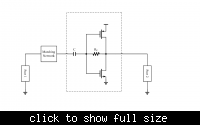hhxuexia
Newbie level 6

hi,
I am designing a low noise amplifier with the structure shown below. The impedance of port1 is 50 ohm.

1. when I change the impedance of port2 from 50 ohm to 100 ohm, the voltage gain from port1 to port2 inreases, but noise figure(NF) remains the same. I am confused with it, since the gain changes, why noise figure does not change at all?
2. if the input impedance of LNA(circuits in dashed block) is exactly 50 ohm, then do we still need the impedance matching network?
Thansk!
I am designing a low noise amplifier with the structure shown below. The impedance of port1 is 50 ohm.

1. when I change the impedance of port2 from 50 ohm to 100 ohm, the voltage gain from port1 to port2 inreases, but noise figure(NF) remains the same. I am confused with it, since the gain changes, why noise figure does not change at all?
2. if the input impedance of LNA(circuits in dashed block) is exactly 50 ohm, then do we still need the impedance matching network?
Thansk!
